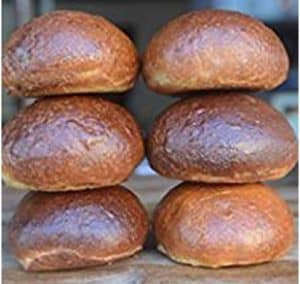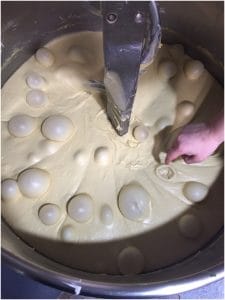We had to take a break from posting on our blog but lately we have so much news that we just have to share with you. Leyla is the creator in our family, and I guess I am a writer who wants the world to know how talented his wife is and how much she does for people to be healthy and happy. We don’t have any secrets. In fact our dream is for people to learn all these simple techniques to cook for their families, which will make a positive difference in their lives. In the past ten years, we’ve gained some experience and I will try to share some of them in this blog.
Customers have lately asked: What exactly do we mean when we say “yeast-free bread and burger buns?” We mean our breads have natural yeast, not commercial -when organic grapes, pears, or plums are being used to naturally ferment dough. That’s exactly what Leyla tried, when she started experimenting with natural yeast. Of course I was encouraging her. Both of us witnessed how our grandmothers, would make their own yeast starter and keep it in a cellar – which was one of the best places in the house because all kinds of canned goods – jellies, pickling, compotes, purified butter, and cured lamb fat were kept there. Our grandfathers most likely kept a bottle or two of house made mulberry vodka to share with guests and family.
Because of the mountainous area we lived in, it was always chilly in the cellar. House canned goods were stored to get families through the cold season, when the markets will be colorless and nature was resting.
While our grandmas were using natural yeast to feed their family, Leyla decided to use naturally fermented dough in our restaurant to make sourdough bread for sandwiches, sourdough challah bread for our French toast and sourdough buns for our burgers. Sourdough Challah bread is a challenge by itself – try to make something sweet out of something sour! Additional ingredients such as milk and butter change the consistency of a dough. They need to be incorporated while adjusting the temperature and kneading – and Leyla did it.
After much trial and error she figured out how much starter we needed to have to produce enough baked goods for our operation to run smoothly. Then she provided training for our employees on how to keep the starter, when to take it out from the fridge and how long to knead. The temperature and the right amount of simple ingredients are crucial every time when making the starter. Her technique is something she can be proud of. If you know another restaurant that does this, I would like to know who they are so we can join our efforts in order to make the healthiest bread there is.
Now without further ado, I’d like to provide you with the secret.
There is none.
Just a few simple steps.
- Basically she smashed 4 oz of organic grapes, and placed the smashed mixture in cheesecloth and mixed it in with 4 oz of organic flour and 4 oz of water.
- Cover and keep everything at room temperature for a week.
- Then take the cheesecloth with grapes out and for another 7 days “feed” the mixture. Every day and a half she added equal portions of flour and water to already existing mixture.
- First 36 hours add 4oz of water and flour .
- Second 36 hours add 8oz of water and flour.
- Third 36 hours 16 oz of water and flour.
- Forth time 72oz of each ingredient.
- And fifth time respectively 144oz of each ingredient.
Our naturally fermented starter is ready. Half of this mass is left in the refrigerator to be used for future batches of bread, another half is taken out at room temperature. It will be used on our dough as a natural yeast and will help it to rise. While this amount worked out perfectly for restaurant needs, you can share yours with friends and family.
When you are trying to implement something new in the restaurant, it is almost always greeted with doubts and questions. Why are we doing this? Did anybody complain about the bread we were ordering before? We had to make a lot of explanations to justify our endeavor. In our case, it’s always easier for two reasons: our employees already know that we constantly change as we try to bring in seasonal items to our menu, and it’s very easy to justify our actions when everybody benefits from it in the biggest possible way – the food is healthier.
After a few weeks, our employees even named it LoLa as it was something alive. And indeed it was. They had to feed it, constantly monitor it, and make sure that it’s not too hot or too cold – just like a toddler.
Why is slow-rise dough MUCH BETTER than the bread made with commercial yeast? Nature created grains with a self defense mechanism that prevents the grain from breaking down. That’s why it’s easy to store them and they don’t go bad for a long time. However, you do need them to be broken down to help your digestive system, so the secret is giving the process time while grains decompose revealing all the nutrients and therefore become stomach-friendly. With commercial yeast, bread rises much faster but without breaking down any of the phytic acid or anti-nutrients that help with digestion.
We feel honored that we can share our bread with so many people who come to our restaurant. We know they don’t realize it. That’s another reason why we decided to write about it. We’ve also decided to serve our bread to every table for dinner, once we get our new dinner menu going.
When you try to make it, please feel free to ask questions. Making this recipe will take some time and you might fail a few times before getting the right result. But believe me, it is so rewarding in the end knowing that you are feeding your kids the right way.
We buy our organic wheat flour from Sperry General Mills in Minnesota, adding Lola and water to it and that’s all.
I suspect I would want to share with you more about Leyla’s cooking. As I was telling her that I would like to write about her sourdough bread, she just dropped : “You can mention that I will be making sourdough pahlava”



